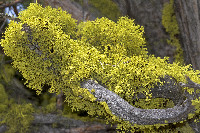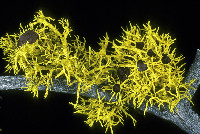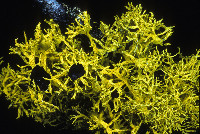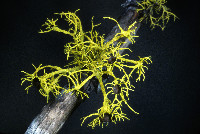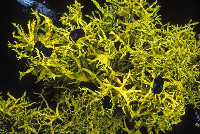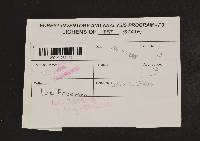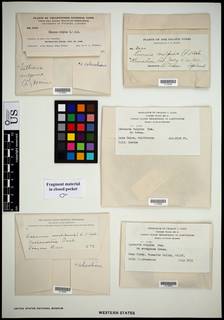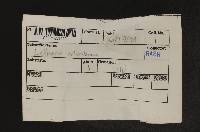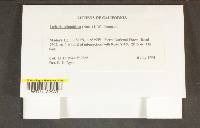
Consortium of Lichen Herbaria
- building a Global Consortium of Bryophytes and Lichens as keystones of cryptobiotic communities -
- Home
- Search
- Images
- Species Checklists
- US States: O-Z >
- US National Parks
- Central America
- South America
- US National Parks
- Southern Subpolar Region
|
|
|
|
Family: Parmeliaceae
[Borrera columbiana Nutt., moreLetharia californica (Lév.) Hue] |
Nash, T.H., Ryan, B.D., Gries, C., Bungartz, F., (eds.) 2002. Lichen Flora of the Greater Sonoran Desert Region. Vol 1. Thallus: (2-) 3-11 (-17) cm tall, tufted to subpendulous, attached by a distinct basal disc, c. 0.2 mm diam. near the base; branching loose, intricately irregular or anisotomically di-(tetra-)chotomous to almost isotomic near the ultimate branches, often divaricate, axils acute to obtuse, rounded branches: c. 0.5-3 (-4) mm wide, unevenly thickened, subterete to angular, or irregularly flattened, especially just below the axils; higher order branches: terminating in attenuated, subulate, forked divisions; short, narrow, ± isidia-like "branchlets" sometimes abundant near base surface: bright greenish yellow or chartreuse yellow-green, abraded areas often slightly paler or brighter yellow, extreme tips of branches and branchlets often ± brown, trunk near the base dark grayish brown to blackish; dull to ± shiny, shallowly to rather deeply lacunose/ foveolate (smaller branches) or channelled/ grooved, with wrinkles and ridges, which are often reticulate and strongly flexuous-sinuous cortex: sometimes cracked transversely, occasionally finely and shallowly rimulose in places medulla: white, appearing slightly lustrous, arachnoid or fibrous, ± loose but partly conglutinated into several (c. 5-10) narrow, ± longitudinal hyphal bundles ± separated by gaps Apothecia: usually common, up to 22 mm diam., solitary or often occurring in two's or three's, sessile, terminating the shorter restricted branches, and irregularly hollow in the center; disc: dark grayish to reddish brown, or deep brown, occasionally with patches the thin brown layer broken off or abraded, showing a distinctly yellow layer underneath), dull to lustrous or slightly shiny, epruinose, deeply concave when young (< c. 3 mm across, becoming undulate and irregularly folded, often deeply depressed towards the center; thalline margin: c. 0.1 (-0.2) mm wide, strongly raised and inflexed when young, soon level with the disc, with few to many ± elongated projections ("lobules" or "fibrils") formed almost from the start and having similar appearance and structure to the smaller branches of the thallus, 0.5-1 cm long and 1 mm wide at the base but soon narrowing and gradually attenuating to roundish or ± pointed tips, the longer ones often branching; surface of lobules and underside of margin often strongly foveolate or lacunose; epihymenium: c. 15 micrometer plus minus deep yellow-brown; hymenium: c. 25-40 micrometer, hyaline to pale yellowish asci: c. 20-25 x 10-15 micrometer, 8-spored ascospores: ellipsoid, c. 7.5-8 x 3.5-4 micrometer Pycnidia: absent to more often frequent, in section c. 0.75 micrometer diam. conidia: arcuate, apparently uniform in thickness, c. 8-10 micrometer long Spot tests: cortex and medulla: K-, C-, KC-, P- Secondary products: cortex with vulpinic acid. Substrate and ecology: on bark or wood of conifers, in open, well-ventilated intermontane forests, usually growing high on trunks, sometimes on dead branches World distribution: western North America with a distribution similar to that of L. vulpina Sonoran distribution: frequent in southern California at 1525-2570 m; Baja California at 980-1400 m in chaparral; rare in Sonora and Arizona. Notes: It often occurs with L. vulpina and differs from it mainly in lacking soredia and usually having abundant apothecia and/or pycnidia. At least in the Sonoran region, L. columbiana often has rather coarse and weakly divided main branches, but occasionally smaller specimens are finer and more densely branched. Most older North American descriptions of L. vulpina (e.g., those of Herre 1910, Hasse 1913, Fink 1935, and Howard 1950, include fertile material (now L. columbiana). The information in the present account is based on my own observations, primarily of material from the Sonoran Region, and may not entirely apply over the full geographic range of these taxa. Small, globose to elongate and branched, isidia-like structures, which can break off and establish new thalli, are often present in both species.
Morphologically, material of L. columbiana s. lato from the Sonoran region, though rather variable in color, branching, and development of isidia, appears to correspond mostly to the L. rugosa type of Kroken and Taylor (2001), characterized mainly by the wrinkled or veined surface (especially evident on the larger branches and the undersides of the apothecial margins). However, these authors also report the L. barbata morph (with a smoother thallus and more richly ciliate apothecial margins) from southern California. Material from chaparral and other rather arid low to moderate elevation sites may represent an additional taxon. |
|
|
|
Powered by Symbiota




